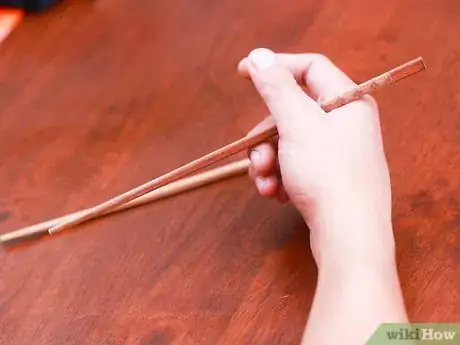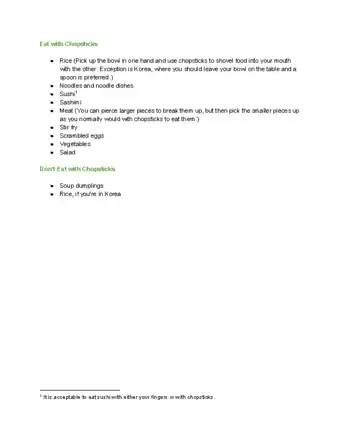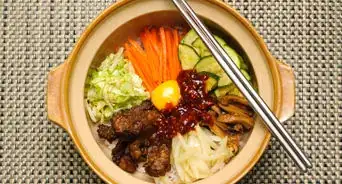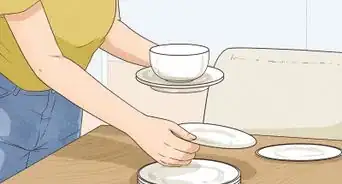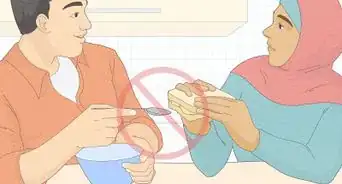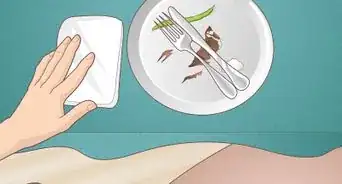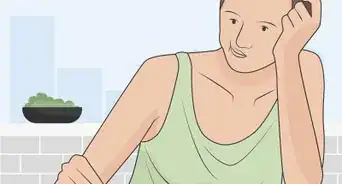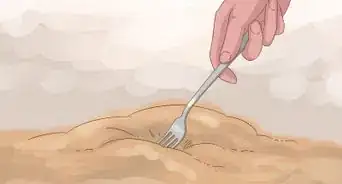This article was co-authored by Yoko Isassi. Yoko Isassi is a Japanese Food Specialist and the Founder of Foodstory in Los Angeles, California. Since 2011, she has taught others how to cook Japanese food and educated others about Japanese food culture. Yoko holds an MA from Columbia University.
There are 11 references cited in this article, which can be found at the bottom of the page.
wikiHow marks an article as reader-approved once it receives enough positive feedback. This article received 43 testimonials and 90% of readers who voted found it helpful, earning it our reader-approved status.
This article has been viewed 2,078,532 times.
Chopsticks are a type of dining utensil typically used to eat East Asian cuisine. Though it may seem confusing or complicated at first, eating with chopsticks is fairly easy once you know how to hold and maneuver the sticks properly.
Things You Should Know
- Place one chopstick in the spot where your index finger and thumb connect and grip the second between those two fingers.
- Practice opening and closing the chopsticks once you have a good grip on them, and then try picking up food.
- Learn chopstick etiquette, including how to share food, what to do with them when you’re not eating, and how to eat rice with them.
Steps
The Maneuvering
-
1Pick up the first chopstick and place it between where your index finger and thumb connect. This one is your anchor -- it should not move. Stiffen your hand for a firm grip. Have the broad end of the chopstick lay in the crook of your hand, where your thumb and pointer finger connect. Rest the narrow end between the base of your thumb and the side of your index finger. It should be virtually immobile.[1] It's similar to how you hold a pen, but a bit lower.[2]
- Some may prefer to hold the chopstick on the side of their ring finger, with the tip of their ring finger holding it in place. This frees the middle finger to hold the other chopstick more securely and provides that one with more control. It is a more formal approach.
-
2Grip the second chopstick with your index finger and thumb. This is the stick that moves.[3] Place your thumb over the side of the second chopstick, so it rests above the first. Adjust your grip to a more comfortable position. Make sure the narrow tips of the chopsticks are even with each other to help prevent them from crossing or being unable to "pinch" the food.[4]
- To get them even, you can tap them on the table. Uneven chopsticks will be very difficult to use.
Advertisement -
3Practice opening and closing the chopsticks. Make sure the broad ends of the chopsticks do not make an "X" as this will make it difficult to pick up food. Is only the top one moving? If so, great![5]
- If it helps, move your hand up and down the chopsticks, but maintaining the same position, experimenting with levels of grip. Some find it easier to maneuver closer to the base, others further up.
- You can practice your moves by having both chopsticks' food ends touch each other repeatedly.[6]
-
4Start picking up food! Working from a 45° angle may be easiest right now. Once you have it steady, lift 'er up. If it feels unstable, put it down and try again.[7]
- Once you get good at one type of food, move onto different sizes and textures. When you start feeling really confident, practice with noodles!
Chopstick Etiquette
-
1Know the rules when sharing food. Often at Asian dining tables (whether at home or at a restaurant) means sharing large plates of food. It's not proper to dive into the communal meal with chopsticks that have just been in your mouth![8] You have two options:
- Use a public pair of serving chopsticks that never touch your own (or anybody else's) bowl of rice/food
- Pick with the other (non-eating) end of your chopsticks. That's the broad end that hopefully, you're not chewing on!
-
2Know what to do with them when not eating. The rules of using chopsticks don't end once you have the food in your mouth, unfortunately. Each society has slightly different rules, but in general:[9]
- Don't stick your chopsticks upright in your food. It's looked at as a bad omen and is reminiscent of incense at funerals.
- Don't spear your food with the ends of your chopsticks. If all else fails, it may seem like a good alternative, but it's viewed as impolite.
- Don't pass food from chopstick to chopstick. Also funeral protocol and viewed as bad (or even ominous) table behavior.
- Don't cross your chopsticks. If you're done eating, lay them to the side of your dish on the left.
- Don't point at people with your chopsticks. Pointing, in general, is a no-no in Asian cultures and same goes with chopsticks.
- This page would be far too long if all the rules were listed. These are the basics.
-
3When eating rice, be willing to dig in. If a bowl of rice is placed in front of you and all you have are two small bamboo rods, you may feel like you're up a creek without a paddle. But it's perfectly acceptable (normal, rather) to lift the bowl of rice close to your mouth and work from there. You won't look foolish, you'll look seasoned!
- You may feel a little like the Beast during his dinner with Belle, but rest assured, this is how it's done. Don't shovel the rice into your mouth like a caveman, but do lift up the bowl near to you to prevent rice drippings from accumulating around your eating area.
- Japan has slightly stricter rules regarding this. If you're in China or Vietnam, for example, you may be able to shovel away.[10]
- You may feel a little like the Beast during his dinner with Belle, but rest assured, this is how it's done. Don't shovel the rice into your mouth like a caveman, but do lift up the bowl near to you to prevent rice drippings from accumulating around your eating area.
Chopstick Cheat Sheet
Expert Q&A
-
QuestionIs it okay if I don't hold them right? Am I going to offend guests?
 Thuong TanThuong Tan is a Noodle Expert and the Founder of Noodelist, a food startup producing plant-based instant noodles. Thuong holds a Bachelor’s degree in International Business and Marketing from Haaga-Helia, University of Applied Sciences, and an MBA in Luxury Brand Management from IFA Paris, Polimoda/Shanghai University. Noodelist’s mission is to produce premium plant-based moroheiya noodles that are nutrient-dense, texturally pleasing, and environmentally friendly.
Thuong TanThuong Tan is a Noodle Expert and the Founder of Noodelist, a food startup producing plant-based instant noodles. Thuong holds a Bachelor’s degree in International Business and Marketing from Haaga-Helia, University of Applied Sciences, and an MBA in Luxury Brand Management from IFA Paris, Polimoda/Shanghai University. Noodelist’s mission is to produce premium plant-based moroheiya noodles that are nutrient-dense, texturally pleasing, and environmentally friendly.
Noodle Expert No, I really wouldn't worry about that. I hold my chopsticks a little funny too, and I've been eating noodles for years!
No, I really wouldn't worry about that. I hold my chopsticks a little funny too, and I've been eating noodles for years! -
QuestionShould I ask for a fork if I'm a little embarrassed about messing up with chopsticks?
 Thuong TanThuong Tan is a Noodle Expert and the Founder of Noodelist, a food startup producing plant-based instant noodles. Thuong holds a Bachelor’s degree in International Business and Marketing from Haaga-Helia, University of Applied Sciences, and an MBA in Luxury Brand Management from IFA Paris, Polimoda/Shanghai University. Noodelist’s mission is to produce premium plant-based moroheiya noodles that are nutrient-dense, texturally pleasing, and environmentally friendly.
Thuong TanThuong Tan is a Noodle Expert and the Founder of Noodelist, a food startup producing plant-based instant noodles. Thuong holds a Bachelor’s degree in International Business and Marketing from Haaga-Helia, University of Applied Sciences, and an MBA in Luxury Brand Management from IFA Paris, Polimoda/Shanghai University. Noodelist’s mission is to produce premium plant-based moroheiya noodles that are nutrient-dense, texturally pleasing, and environmentally friendly.
Noodle Expert You can! If chopsticks are going to keep you from enjoying your food, then just ask for a fork. There's nothing wrong with that. But honestly, I'd say you should just go for it with the chopsticks. Don't be nervous. Nobody is going to expect you to be a chopstick pro if you didn't grow up with them!
You can! If chopsticks are going to keep you from enjoying your food, then just ask for a fork. There's nothing wrong with that. But honestly, I'd say you should just go for it with the chopsticks. Don't be nervous. Nobody is going to expect you to be a chopstick pro if you didn't grow up with them! -
QuestionHow do you eat with chopsticks if you're a total beginner?
 Thuong TanThuong Tan is a Noodle Expert and the Founder of Noodelist, a food startup producing plant-based instant noodles. Thuong holds a Bachelor’s degree in International Business and Marketing from Haaga-Helia, University of Applied Sciences, and an MBA in Luxury Brand Management from IFA Paris, Polimoda/Shanghai University. Noodelist’s mission is to produce premium plant-based moroheiya noodles that are nutrient-dense, texturally pleasing, and environmentally friendly.
Thuong TanThuong Tan is a Noodle Expert and the Founder of Noodelist, a food startup producing plant-based instant noodles. Thuong holds a Bachelor’s degree in International Business and Marketing from Haaga-Helia, University of Applied Sciences, and an MBA in Luxury Brand Management from IFA Paris, Polimoda/Shanghai University. Noodelist’s mission is to produce premium plant-based moroheiya noodles that are nutrient-dense, texturally pleasing, and environmentally friendly.
Noodle Expert Depending on where you are, you can take a small bit of paper and a rubber band to create a kind of joint. These are typically given to kids, but they're great if you're brand new to chopsticks. They really let you get a feel for them in your hand.
Depending on where you are, you can take a small bit of paper and a rubber band to create a kind of joint. These are typically given to kids, but they're great if you're brand new to chopsticks. They really let you get a feel for them in your hand.
Warnings
- Do not hit the bowl or plate with your chopsticks. It was what beggars did in ancient China.⧼thumbs_response⧽
- Do not pick your teeth with your chopsticks, even if there is no toothpick where you dine.⧼thumbs_response⧽
- Decide which food in the dish you want before putting your chopsticks in it. Picking at things in the dish is considered very impolite.⧼thumbs_response⧽
- Avoid passing food with chopsticks. This resembles a section of the traditional Japanese funeral, where the family members pass bones using chopsticks.[12] Instead, when passing food, place the food on an intermediary plate, preferably using a serving utensil or, if none is provided, turn your chopsticks around so the ends that have not been in your mouth touch the food, then give the plate to whomever.⧼thumbs_response⧽
- Chinese etiquette says that you may lift your personal rice bowl close to your mouth with one hand, as you use the chopsticks to push the rice into your mouth. However, Korean etiquette says this is very bad form! Be aware of the people you are eating with, and what the customs are.[13]⧼thumbs_response⧽
Things You'll Need
- Chopsticks
- Food
References
- ↑ Yoko Isassi. Japanese Food Specialist. Expert Interview. 30 August 2021.
- ↑ https://thewoksoflife.com/how-to/how-to-use-chopsticks/
- ↑ Yoko Isassi. Japanese Food Specialist. Expert Interview. 30 August 2021.
- ↑ https://www.pandabambu.com/tips-of-how-to-use-chopsticks/
- ↑ https://kotaku.com/how-to-use-chopsticks-1689350890
- ↑ Yoko Isassi. Japanese Food Specialist. Expert Interview. 30 August 2021.
- ↑ http://www.arrowscientific.com.au/index.php?option=com_content&view=article&id=25:chopsticks-formula-to-ease-fears&catid=16&Itemid=29
- ↑ https://www.fluentu.com/blog/japanese/introduction-japanese-chopstick-etiquette/
- ↑ http://justhungry.com/your-guide-better-chopstick-etiquette-mostly-japanese
- ↑ http://www.china-family-adventure.com/how-to-eat-with-chopsticks.html
- ↑ https://blog.opentable.com/2017/sushi-etiquette-dos-and-donts-from-6-top-sushi-chefs-hackdining/
- ↑ https://www.japan-talk.com/jt/new/10-golden-rules-for-japanese-chopstick-manners
- ↑ https://everythingchopsticks.com/Guide-to-Chopsticks-Etiquette-Around-the-World.html
About This Article
To eat with chopsticks, first place one chopstick between your dominant index finger and your thumb. Curl your ring finger and rest the middle of the chopstick on top to balance it. Then, place the second chopstick above the first chopstick, in between your index finger and thumb. Rest the upper chopstick on top of your middle finger, and use your thumb and middle finger to grip it tighter than the lower chopstick. To pick up food with the chopsticks, use your middle and index fingers to move the upper chopstick around the food. Apply pressure with your index finger on top of the upper chopstick to grip the food so you can lift it off of your plate. Keep reading if you want to learn proper chopstick etiquette!
